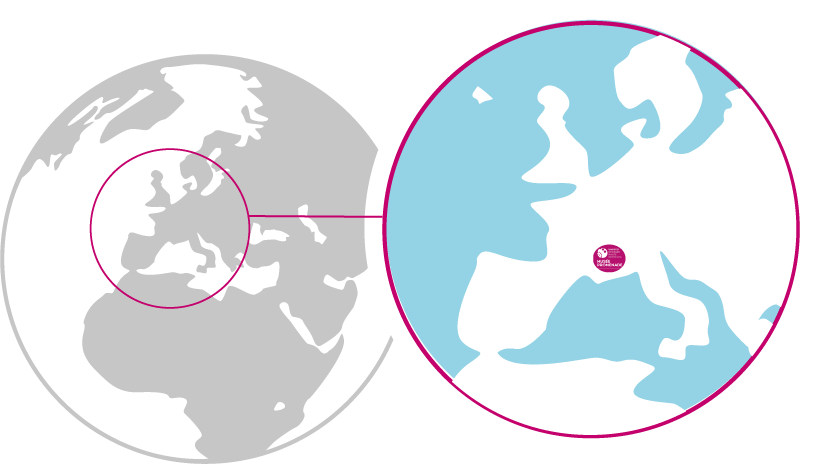A turbulent and eventful local geological history
The Haute-Provence UNESCO Global Geopark spans an area in the Southern Alps from the lake of Sainte-Croix on the Verdon river to the lake of Serre-Ponçon on the Durance river. The Tête de l'Estrop mountain is only 40 metres short of joining the "3,000 metre" club, yet this geographical region was under the sea for hundreds of millions of years. It was the collision of the African geological-plate with the European one that gave birth to the Alps where we are today.
The extraordinary history of the Haute-Provence UNESCO Global Geopark began 300 million years ago with tropical forests of tree ferns.
Several episodes followed one another :
The Triassic period with its lagoons in an very dry climate;
The Jurassic and Cretaceous seas, which gradually deepened in a variety of environments, were teeming with life, including ammonites, belemnites, ichthyosaurs and fish. A large part of the sediments that formed the rocks of today's mountains were deposited there. The geological basins gradually filled in.
The Tertiary Era (or Cenozoic period) is the period when the alpine mountains were formed. The sea occupied various areas before it finally withdraws, and the sediments that are deposited are quite different from the previous deposited sediments. Sediments are also deposited in lakes and rivers, which make up an extensive part of the landscape.
In the Quaternary period, the area of the current Haute-Provence UNESCO Global Geopark was exposed and the glaciers came down from the higher Alps into our valleys. Since their retreat 15,000 years ago, Humans have shaped and modified this territory.
The Carboniferous period, a nod to the Primary Era
The Carboniferous rocks were deposited about 300 million years ago at a time when our region was covered with forests of tree ferns, giant horsetails and the ancestors of today's conifers. They lived in a warm and humid equatorial climate.
The analysis of the rocks shows a swampy floodplain environment. The plant debris was quickly and regularly buried in the sediments, causing the formation of coal layers.
However, there is no trace of deposits from the next period, the Permian period (298 to 252 million years ago), which ends the Primary Era. It is likely that our region was then a mountaineous , hilly terrain (within the Hercynian mountain range) exposed and prone to erosion where there were no deposits (much like today).
In addition to the largest mass extinction in the living world, the end of the Primary Era is also marked by climate change and the erosion of the Hercynian mountain range.
The Triassic period: time for gypsum.
In the Triassic period, the single super-continent called Pangea gradually broke up into two parts separated by a marine area : the Tethys Ocean was established between the land-mass Laurasia in the north and the land-mass Gondwana in the south. Our current region lay on the southern coastal edges of Laurasia.
The Lower Triassic rocks are rather rare in our area, in particular the quartzites of the Verdaches gorge which represent ancient quartz sands and gravels carried by rivers.
Subsequently, the most abundant and spectacular rocks are brightly coloured argillites which are often associated with large deposits of gypsum.
Gypsum was deposited in a lagoon environment in a hot, very dry climate, and is an evaporite like the salt and anhydrite that often accompany it.
Gypsum plays an important role in the structuring of the Alpine chain by facilitating the movement of large rock panels due to its flexible high plasticity or malleability . It is called a soap layer (a fragile and deformable level on which large rocky blocks or sheets can slide).
Gypsum is also a traditional natural material which has been mined and used by humans extensively in construction, especially in older buildings. Every village that could do so used to mine and produce its own plaster for its local needs.
The Lower Jurassic period (Lias period): the early beginnings of the sea
In the Lias period, the ocean marine space deepens and expands as a result of oceanic expansion; our current region was completely underwater at that point. The submarine topography is rugged and irregular due to the affects of geological fault-lines that shift large panels of the earth's crust. The sediments that are deposited are shaped and moulded by this uneven underground topography. The sediments became limestone, marl or marl-limestone depending on the depth, the level of agitation and disturbance as well as the distance from the shore.
In our current geographical territory there are big differences between the south, with its Provencal origins and features, where the deposits are more coastal and less thick, and the north, with its Dauphin origins and features, where the deposits are more pelagic-like (originating in deeper open-sea areas) thus thicker.
The sea is full of life and fossils are abundant. Some of the most emblematic sites in the Geopark date from this period : the Ammonite Fossil Rock-Slab, the ichthyosaurus at La Robine, the the cutbacks (or hairpin bends) at Astoin.
The Middle and Upper Jurassic period (Dogger period and Malm period).
In the Middle and Upper Jurassic period, the sea is still very present and widens further. The depth of the sea varies due to global fluctuations. The rocks resulting from the sediments deposited at this time are quite characteristic in the current landscape. Above the ledge formed by marl and limestone alternations during the Bajocian-Bathonian periods lie the imposing Terres Noires, (Black Lands or Badlands rock formations), famous for their lunar landscapes. They are crowned by the cliffs of limestone from the Tithonian period, which closes the Jurassic period and extends a little into the Cretaceous period.
This thick limestone formation is an easily identifiable landmark. It forms a large part of the landscape's terrain: the Dourbes and Gache mountains, the Reynier ridge, etc. It constitutes the majority of the gorges found in the Geopark : the gorges at Barles , Chabrières, Bayons , Sisteron
The Cretaceous period
The sea still covers the territory of the future Geopark. It first deposits marl and limestone (Barremian, for example) with beautiful ammonite fauna.
This is followed by thick layers of black marl, such as those that yielded the ichthyosaurus at Chanolles.
During the latter part of this period, very thick layers of light-coloured limestone are deposited, indicating a decrease in the depth of the sea.
The Cretaceous period is also the period when the formation of the Alps begins. Around 80 million years ago, the movement of the earth's tectonic plates forced the opening and widening of the Atlantic Ocean which pushes the continent of Africa north-eastwards, which in turn leads to the formation of the Alps and landscapes bordering the Mediterranean area.
The first east-west elongated geological-folds appear : the Luberon and Lure mountain ranges. The first emerged, exposed lands are eroded by hot climates.
The Tertiary Era
At the beginning of the Tertiary Era, the entire territory of the Geopark emerged above water because the movements that began in the Cretaceous period continued. The layers deposited during the Secondary Era were deformed, folded, piled up on top of each other and rose up from the water. Their exposure leaves them prone to erosion.
During the Eocene period, the north-eastern edge of the Geopark territory is once again covered by the sea. Limestone, marl and sandstone are deposited. These sandstones are very abundant to the east part of the Geopark, in Annot, but they also crown the peaks of the Estrop mountain. The rest of the territory is also home to many rock-formations caused by continental-shifs.
During the Oligocene period, the collision of the landmass of Africa and the landmass of Europe became more pronounced in a rotational movement that combined the geological effects of compression and extension.
In our region, deposits called "red mudstone" accumulated gravel, sand and clay brought down from the young alpine terrains by the erosion of the tropical climate.
In the Miocene period, the formation of the Alps continued and reached its peak. The chain is encircled by a shallow inlet that runs from the shores of the modern Mediterranean to Austria. In our region, fossil beaches are piled up hundreds of metres thick. There are various fossils, bird prints and even the rhythm of the tides have been recorded in bedrocks.
The Late Tertiary Era and Quaternary period
In the second part of the Miocene period and then during the Pliocene and Quaternary periods, the movements of the earth's tectonic plates that formed the Alps altered leading to the formation of the Mediterranean Sea. The rivers that drain the Geopark now flow towards it.
It's evolution influenced the erosion and sedimentation of the whole territory. Around 5 million years ago, when the region started to dry up, all the rivers began to dig deep, narrow gorges to catch up with the fast descending water levels. When the area fills up again with rising waters, sedimentation fills in these canyons.
Two major features of the present landscape take shape at this time. Firstly, the geological fault-line that has been running for tens of millions of years under the present-day Durance valley between the Mirabeau bridge and Sisteron defines the western edge of a basin-valley that accommodates the debris materials of erosion carried by the Durance river, the Bléone river, the Asse river... creating what is known today as the plain of Valensole with its millions of pebbles, the surface of this bassin-plain corresponds to the filling of this basin-valley.
Secondly, a thick block of land (nearly 2,000m thick) moves from north to south, guided by large geological fault-lines linked to the same fault-lines as the Durance valley and thanks to the presence at its base of gypsum, a soft, soluble rock that acts as a "slippy" soap layer, ulimately forming the Digne nappe (geological thrust-sheet) which constitutes the whole of the landscape's terrain which surrounds the town and is a large part of the terrain and landscape of the Geopark.
Finally, the glaciers left their mark on the territory, especially the Durance and Ubaye glaciers which overflowed from the north into the territory our Geopark. We attribute to them the shaping of the Seyne valley, for example, and the glacial deposition of moraines and residual peat bogs after their departure. Further south, the retreating glaciers influence on the sea level can be seen in the different stages of the channelling or digging-out of the valleys resulting in the formation of varying levels of pebbled terraces that are visible today along the base of the valley.







